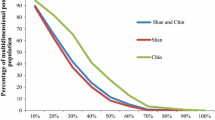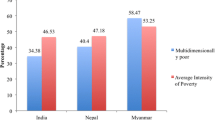Abstract
The present study applies a composite index, after compensating livelihood vulnerability index and climatic vulnerability index, where the core part lies with the foundation of IPCC’s model. The encompassing subject of appraisal is the multidimensional poverty and vulnerability conditions of snake charmers in two eastern states of India (Bihar and Odisha), due to external shocks and stressors coming from the stringent environment laws and the effect of globalization. Here, three major dimensions (i.e. exposure, adaptive capacity and sensitivity), eight major components (i.e. socio-demographic profile, livelihood strategies, social network, food, health, water, impact of laws, and impact of globalization), and 82 sub-components or indicators have been integrated in accordance with the requirement of the study, for addressing the survival vulnerability of this marginal group. Based on the survey of 208 (Bihar) and 226 (Odisha) household data, a customized index is computed and varied dimension-wise and major component-wise vulnerabilities are compared spatially. The results have established almost similar scenarios of survival vulnerability of snake charmers across the states. Whereas in the two respective states the dimension of exposure is higher than rest dimensions like adaptive capacity and sensitivity, and this dimension indirectly affects the other two, which creates the ultimate vulnerability and not only reduces the resiliencies for adaptation but also enhance the magnitude of sensitivity. This pragmatic SuVI would be useful for assessing the vulnerability of any marginal group and also for reframing crisis-oriented policy and program, precisely for breaking the ‘chain’ of the vicious circle of misery from snake charmers’ lives.

Source: Developed by authors (based on IPCC’s model 2007)




Source: Developed by authors
Similar content being viewed by others
References
Abraham RA, Kavi KKS (2008) Multidimensional poverty and vulnerability. Econ Polit Wkly 43(20):77–87
Adger WN (2006) Vulnerability. Glob Environ Chang 16:268–281
Alam GMM (2017) Livelihood cycle and vulnerability of rural households to climate change and hazards in Bangladesh. Environ Manag 59(5):777–791. https://doi.org/10.1007/s00267-017-0826-3
Alam GMM, Alam K, Shahbaz M (2016) Influence of institutional access and social capital on adaptation choice: empirical evidence from vulnerable rural households in Bangladesh. Ecol Econ 130:243–251. https://doi.org/10.1016/j.ecolecon.2016.07.012
Alam GMM, Alam K, Shahbaz M, Clarke ML (2017) Drivers of vulnerability to climatic change in riparian char and river-bank households in Bangladesh: implications for policy, livelihoods and social development. Ecol 72:23–32
Alkire S, Foster J (2011) Counting and multidimensional poverty measurement. J Public Econ 95(78):476–487
Aryal S, Cockfield G, Maraseni TN (2014) Vulnerability of Himalayan transhumant communities to climate change. Clim Change 125(2):193–208. https://doi.org/10.1007/s10584-014-1157-5
Balasubramanian A (2013) Bihar—at a glance (a video documentary script). Centre for Advanced Studies and Earth Science. University of Mysore, pp 1–10. https://www.researchgate.net/publication/320735842. Accessed 11 Oct 2019
Birkmann J, Wisner B (2005) Measuring the un-measurable the challenge of vulnerability. In: Report of the second meeting of the UNU-EHS expert working group on measuring vulnerability, 12–14 October 2005, Bonn, Germany, pp 10–58
Calvo C (2008) Vulnerability to multidimensional poverty: Peru, 1998–2002. World Dev 36(6):1011–1020. https://doi.org/10.1016/j.worlddev.2007.10.001
Cannon T (2008) Reducing people’s vulnerability to natural hazards: communities and resilience. Research Paper No. 2008/34. Helsinki, Finland, WIDER
Chambers R (1989) Vulnerability, coping and policy. Inst Dev Stud Bull 20(2):1–7. https://doi.org/10.1111/j.1759-5436.1989.mp2002001.x
Cochran WG (1977) Sampling techniques, 3rd edn. Wiley, New York
Cutter SL, Boruff BJ, Shirley WL (2003) Social vulnerability to environmental hazards. Soc Sci Q 84(2):242–261. https://doi.org/10.1111/1540-6237.8402002
Das R (2011) NiritatterAlokayBediaJonozathi, Songscriti, EtihasAbongMonosaKabbo (The Culture of Bediya Community and EpicManasamagala: An Anthropological View). Juthica Book Stall, Kolkata
Eriksen S, Kelly P (2007) Developing credible vulnerability indicators for climate adaptation policy assessment. Mitig Adapt Strat Gl 12:495–524. https://doi.org/10.1007/s11027-006-3460-6
Eriksen SH, O’Brien K (2007) Vulnerability, poverty and the need for sustainable adaptation measures. Clim Policy 7:337–352. https://doi.org/10.1080/14693062.2007.9685660
Etwire PM, Al-Hassan RM, Kuwornu JKM, Osei-Owusu Y (2013) Application of livelihood vulnerability index in assessing vulnerability to climate change and variability in Northern Ghana. J Environ Earth Sci 3:157–170
Feeny S, McDonald L (2015) Vulnerability to multidimensional poverty: findings from households in Melanesia. J Dev Stud 52(3):447–464. https://doi.org/10.1080/00220388.2015.1075974
Fraser ED, Dougill AJ, Hubacek K, Quinn CH, Sendzimir J, Termansen M (2011) Assessing vulnerability to climate change in dryland livelihood systems: conceptual challenges and interdisciplinary solutions. Ecol Soc 16(3):33–42. https://doi.org/10.5751/ES-03402-160303
Füssel HM (2010) How inequitable is the global distribution of responsibility, capability, and vulnerability to climate change: a comprehensive indicator-based assessment. Glob Environ Chang 20(4):597–611. https://doi.org/10.1016/j.gloenvcha.2010.07.009
Gallopín GC (2006) Linkages between vulnerability, resilience, and adaptive capacity. Glob Environ Chang 16:293–303. https://doi.org/10.1016/j.gloenvcha.2006.02.004
Garg KC, Kumar S (2016) Scientometric profile of an Indian state: the case study of Odisha. Collent J Scientometr Inf Manag 10(1):141–153. https://doi.org/10.1080/09737766.2016.1177950
Gbetibouo GA, Ringler C, Hassan R (2010) Vulnerability of the South African farming sector to climate change: an indicator approach. Nat Resour Forum 34(3):175–187. https://doi.org/10.1111/j.1477-8947.2010.01302.x
GECHS (1999) Global environmental change and human security. GECHS Science Plan IHDP, Bonn
Hahn MB, Riederer AM, Foster SO (2009) The livelihood vulnerability index: a pragmatic approach to assessing risk from climate variability and change—a case study in Mozambique. Glob Environ Chang 19:74–88
Halder S (2018) Political ecology of snake charming: evidence from West Bengal, India. South Asian Surv 24(1):54–87. https://doi.org/10.1177/0971523118783373
Hufschmidt G (2011) A comparative analysis of several vulnerability concepts. Nat Hazards 58:621–643
ICDS (2017) District Manual: Integrated Child Development Scheme. Ministry of Health & Family Welfare, Government of India, pp 1–28. https://darpg.gov.in/sites/default/files/ICDS.pdf. Accessed 3 Mar 2018
IPCC (2007) Climate change 2007: impact, adaptation and vulnerability, Fourth assessment report. In: Intergovernmental Panel on Climate Change. Cambridge University Press, Cambridge
Jana NC, Ghosh PK (2015) Socio-economic conditions and quality of life in the tribal areas of Orissa with special reference to Mayurbhanj district. Sp Cult India 3(2):25–41
Kirby P (2006) Vulnerability and violence: the impact of globalisation. Pluto Press, London
Kumar S (2004) Janata regionalised: contrasting bases of electoral support in Bihar and Orissa. In: Jenkins R (ed) Regional reflections: Comparing politics in Indian states. Oxford University Press, Delhi, pp 2–28
Lawson A (2003) Snake charmers fight for survival. BBC News, World Edition (South Asia). https://news.bbc.co.uk/2/hi/south_asia/2733039.stm. Accessed 10 Jan 2014
Leichenko R, O’Brien K (2008) Environmental change and globalization: double exposure. Oxford University Press, New York
Lobato-Calleros M, Fabila K, Shaw P, Robert B (2018) Quality assessment methods for index of community sustainability. Bus Process Manag J. https://doi.org/10.1108/BPMJ-02-2018-0042
Madhawi R, Pandey A, Raj S, Mandal M, Devi S, Sinha PK et al (2018) Geographical pattern of carcinoma gallbladder in Bihar and its association with river Ganges and arsenic level: retrospective individual consecutive patient data from Regional Cancer Centre. South Asian J Cancer 7:167–170
Magnier M (2012) India snake charmers have identity crisis. Los Angeles Times website: https://articles.latimes.com/2012/feb/21/world/la-fg-india-snakes-20120222. Accessed 11 Jan 2014
Malaviya P, Picado A, Singh SP, Hasker E, Singh RP et al (2011) Visceral Leishmaniasis in Muzaffarpur District, Bihar, India from 1990 to 2008. PLoS ONE 6(3):1–7. https://doi.org/10.1371/journal.pone.0014751
Nair M (2011) Uncharming life of snake charmers. The Economic Times. https://economictimes.indiatimes.com/industry/uncharming-life-of-snake-charmers/articleshow/8076528.cms. Accessed 14 Jan 2014
O’Brien K, Quinlan T, Ziervogel G (2009) Vulnerability interventions in the context of multiple stressors: lessons from the Southern Africa Vulnerability Initiative (SAVI). Environ Sci Policy 12(1):23–32. https://doi.org/10.1016/j.envsci.2008.10.008
Ostrom E (2007) A diagnostic approach for going beyond panaceas. PNAS 104(39):15181–15187. https://doi.org/10.1073/pnas.0702288104
Pandey R, Jha SK (2012) Climate vulnerability index-measure of climate change vulnerability to communities: a case of rural lower Himalaya, India. Mitig Adapt Strat Gl 17:487–506. https://doi.org/10.1007/s11027-001-9338-2
Panthil J, Aryal S, Dahal P, Bhandari P, Krakauer NY, Pandey VP (2015) Livelihood vulnerability approach to assessing climate change impacts on mixed agro-livestock smallholders around the Gandaki River basin in Nepal. Reg Environ Change. https://doi.org/10.1007/s10113-015-0833-y
Pathak N (2012) Snake charming: a profession of little charm. Gulf News. https://gulfnews.com/news/asia/india/snake-charming-a-profession-of-little-charm-1.998823. Accessed 8 Feb 2013
Peng L, Xu D, Wang X (2018) Vulnerability of rural household livelihood to climate variability and adaptive strategies in landslide-threatened western mountainous regions of the Three Gorges Reservoir Area. China Clim Dev. https://doi.org/10.1080/17565529.1445613
Preston BL, Yuen EJ, Westaway RM (2011) Putting vulnerability to climate change on the map: a review of approaches, benefits, and risks. Sustain Sci 6(2):177–202. https://doi.org/10.1007/s11625-011-0129-1
Prevention of Cruelty to Animals Act (1960) The Prevention of Cruelty to Animals Act (No. 59 of 1960), The Parliament of India: Government of India, pp 1–19. https://indiacode.nic.in/bitstream/123456789/11237/1/the_prevention_of_cruelty_to_animals_act%2C_1960.pdf Accessed 10 Jan 2020
Shah KU, Dulal HB, Jhonson C, Baptiste A (2013) Understanding livelihood vulnerability to climate change: applying the livelihood vulnerability index in Trinidad and Tobago. Geoforum 47:125–137
Silva G, Miguez M, Di Gregório L, Veról A (2016) Vulnerability index—application and suitability of different methodologies applied to the municipality of Cuiabá, Mato Grosso–Brazil. E3S Web of Conferences, 08013 (2016): 3rd European Conference on Flood Risk Management, pp 3–10. 10.1051/e3sconf/2016
Su J, Morello-Frosch R, Jesdale B, Kyle AD, Shamasunder B, Jerrett M (2009) An index for assessing demographic inequalities in cumulative environmental hazards with application to Los Angeles, California. Environ Sci Technol 43:7626–7634. https://doi.org/10.1021/es901041p
Toufique KA, Islam A (2014) Assessing risks from climate variability and change for disaster-prone zones of Bangladesh. Int J Disast Risk Re 10:236–249. https://doi.org/10.1016/j.ijdrr.2014.08.008
Turner B, Kasperson R, Matson P, McCarthy R, Corell R, Christensen L et al (2003) A framework for vulnerability analysis in sustainability science. Proc Natl Acad Sci 100(14):8074–8079
Wildlife [Protection] Act (1972) The Wildlife [Protection] Act (No. 53 of 1972), The Parliament of India: Government of India, pp 1–74. https://nbaindia.org/uploaded/Biodiversityindia/Legal/15.%2520Wildlife%2520(Protection)%2520Act,%25201972.pdf. Accessed 10 Jan 2020
Wisner B (2016) Vulnerability as concept, model, metric, and tool. Oxford Res Encycl Nat Hazard Sci. https://doi.org/10.1093/acrefore/9780199389407.013.25
Wisner B, Blaikie P, Cannon T, Davis I (2004) At risk: natural hazards, people’s vulnerability and disasters, 2nd edn. Routledge, London
Wisner B, Gaillard JC, Kelman I (2012) Framing disaster: theories and stories seeking to understand hazards, vulnerability and risk. In: Wisner B, Gaillard JC, Kelman I (eds) The Routledge handbook of hazards and disaster risk reduction. Routledge, London, pp 18–34
Wolf T, Chuang W, McGregor G (2015) On the science-policy bridge: do spatial heat vulnerability assessment studies influence policy? Int J Env Res Pub He 12:13321–13349. https://doi.org/10.3390/ijerph121013321
Wood SA, Jina AS, Jain M, Kristjanson P, DeFries RS (2014) Smallholder farmer cropping decisions related to climate variability across multiple regions. Glob Environ Change 25(1):163–172. https://doi.org/10.1016/j.gloenvcha.2013.12.011
Acknowledgements
Firstly, the authors would like to acknowledge the academicians and scientists without their initial contributions (in model building as well as computation) it would be near impossible to build the bases of this study. Secondly, they like to acknowledge the anonymous reviewers for their valuable suggestions and comments, and thirdly anonymous snake charmers, from Bihar and Odisha, who build the foundation of the study.
Funding
This study was not funded by any authority (Government, Private, or any Society of India or Abroad). This study is an enhanced part of doctoral dissertation of the first author. Therefore, this academic work was pursued by the authors and on the basis of self-finance.
Author information
Authors and Affiliations
Corresponding author
Ethics declarations
Conflict of interest
Authors declare that they have no potential conflict of interest with respect to the research, authorship and/or publication of this article. The ideas presented are those of the authors and do not necessarily represent the official position of the institution, they employed (Kaliachak College), or position of the institution from where they were awarded Ph.D. (Visva-Bharati, Santiniketan, India).
Ethical approval
All procedures performed in studies involving human participants were in accordance with the ethical standards of the institutional and/or national research committee and with the 1964 Helsinki declaration and its later amendments or comparable ethical standards. The ground survey was entirely conducted by the authors, thus there was no scope to obtain consent from any field assistant(s). And the authors had taken necessary consents from all individual participants, or respondents (from Bihar and Odisha), included in the study.
Additional information
Publisher's Note
Springer Nature remains neutral with regard to jurisdictional claims in published maps and institutional affiliations.
Electronic supplementary material
Below is the link to the electronic supplementary material.
Rights and permissions
About this article
Cite this article
Halder, S., Paul, S. Modeling multidimensional poverty and vulnerability of snake charmers: a cross-state comparative analysis of Bihar and Odisha, India. Model. Earth Syst. Environ. 6, 2623–2643 (2020). https://doi.org/10.1007/s40808-020-00854-2
Received:
Accepted:
Published:
Issue Date:
DOI: https://doi.org/10.1007/s40808-020-00854-2




